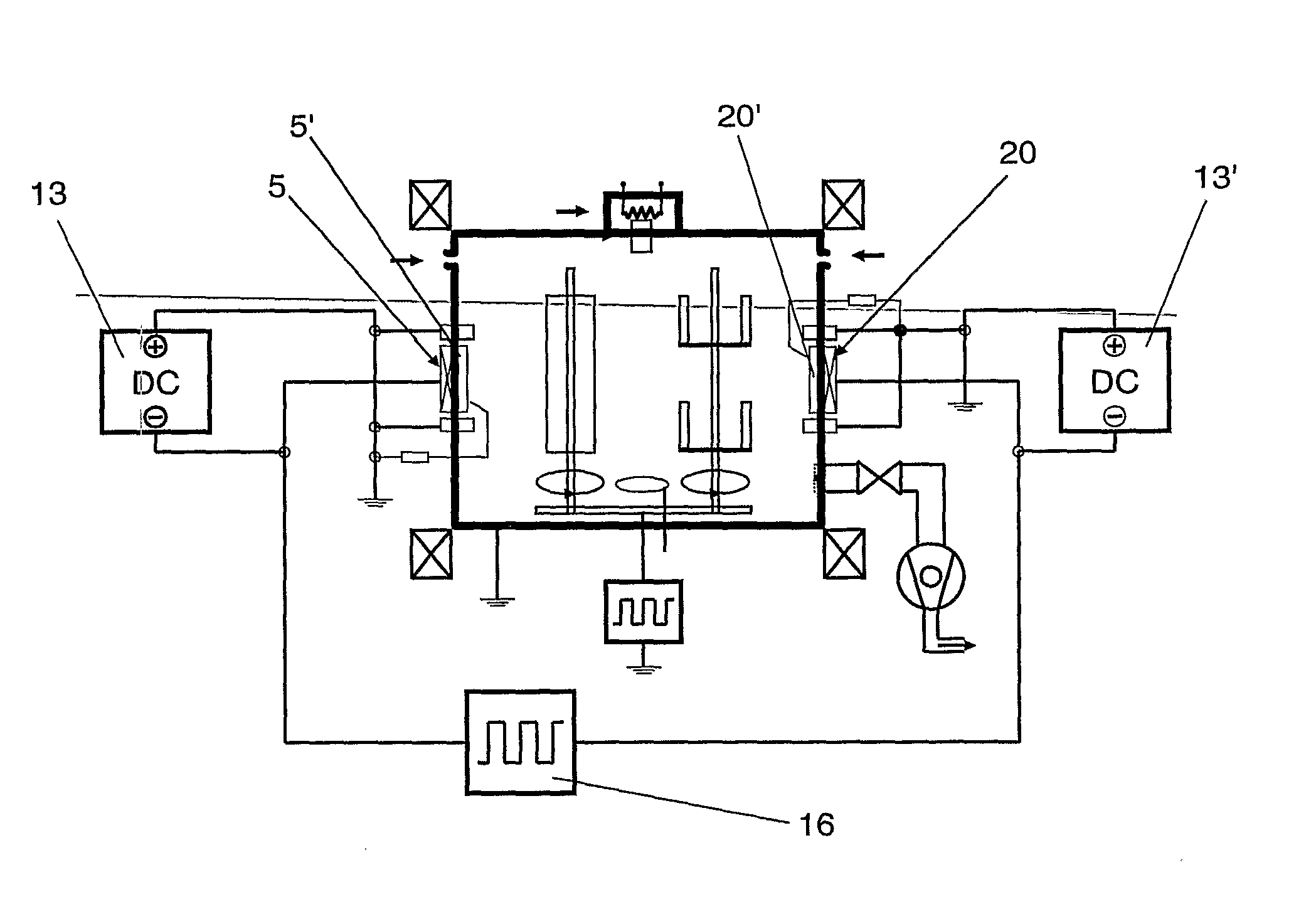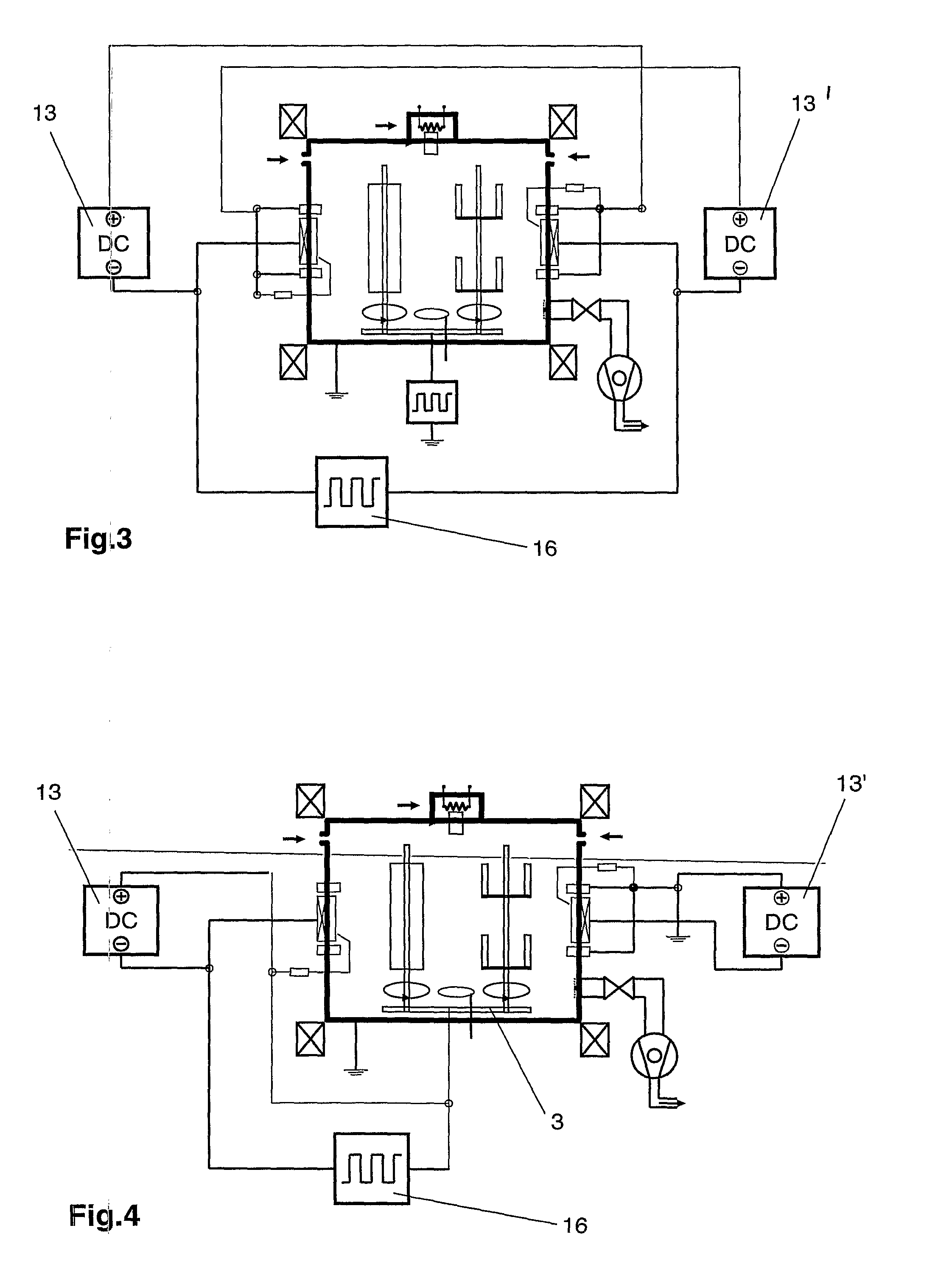Method For Operating a Pulsed Arc Evaporation Source and Vacuum Process System Comprising Said Pulsed Arc Evaporation Source
- Summary
- Abstract
- Description
- Claims
- Application Information
AI Technical Summary
Benefits of technology
Problems solved by technology
Method used
Image
Examples
example 2
[0106]While in the above example the production of an Al—Cr—O layer was described, in which only two spark targets were utilized, in the following the process for a pure aluminum oxide layer utilizing 4 spark targets will be described:
[0107]For the coatings, hard metal indexable inserts (tungsten carbide) were used as substrates, which had already been coated in a preceding process with a 1.5 μm thick TiN layer. The substrates were subjected to a pretreatment, which was substantially identical to the above described steps 1 to 5. Before the coating with the functional layer, no special intermediate layer was deposited, i.e. the functional layer was directly deposited on the TiN base and steps 6 and 7 were omitted. For the deposition of the functional layer (8) work took place with four spark targets and the following process parameters were used:[0108]4 Al targets operated at 170 A DC each[0109]bipolar current pulses, corresponding to FIG. 2, of 2 Al targets each with an output volt...
example 3
[0120]The next example relates to the production of a zirconium oxide layer. Before the coating with the functional layer proper, the substrates were coated with an intermediate layer of ZrN. For this coating 4 targets were used for the work, which was operated at a partial pressure of nitrogen of 2 Pa with 170 A each.
[0121]The substrate temperature was 500° C. and a substrate bias of −150 V was used. The coating time for this intermediate layer was 6 min.
[0122]For the deposition of the functional layer (8) work also took place with four spark targets, corresponding to FIG. 2, and the following process parameters were used:[0123]4 Zr targets operated at 170 A DC each[0124]bipolar current pulses of 2 Zr targets each with an output voltage of 100 V at the power supply and positive and negative pulse widths of 20 μs each[0125]Argon flow: 50 sccm[0126]Oxygen flow: 700 sccm[0127]Substrate bias: DC bipolarly pulsed, + / −40 V, 38 μs negative, 4 μs positive[0128]Substrate temperature: 500° C...
example 4
[0136]In the last example the production and analysis of an SiAlN layer will be discussed.
[0137]Before the coating proper with the functional layer, the substrates were coated with an intermediate layer of TiN. For this coating the work took place with 2 targets, corresponding to FIG. 2, which were operated at 180 A each at a partial pressure of nitrogen of 0.8 Pa. The substrate temperature was 500° C. and a substrate bias of −150 V was used. The coating time for this intermediate layer was 5 min.[0138]2 SiAl targets with a ratio of Si / Al of 70 / 30 were operated at 170 A DC each[0139]bipolar current pulses of the 2 SiAl targets with an output voltage of 100 V at the power supply and positive and negative pulse widths of 20 μs each[0140]Argon flow: 50 sccm[0141]Oxygen flow: 800 sccm[0142]Substrate bias: DC bipolarly pulsed, + / −40 V, 38 μs negative, 4 μs positive[0143]Substrate temperature: 410° C.
[0144]The layer obtained in this manner was characterized through the following measureme...
PUM
 Login to View More
Login to View More Abstract
Description
Claims
Application Information
 Login to View More
Login to View More - R&D
- Intellectual Property
- Life Sciences
- Materials
- Tech Scout
- Unparalleled Data Quality
- Higher Quality Content
- 60% Fewer Hallucinations
Browse by: Latest US Patents, China's latest patents, Technical Efficacy Thesaurus, Application Domain, Technology Topic, Popular Technical Reports.
© 2025 PatSnap. All rights reserved.Legal|Privacy policy|Modern Slavery Act Transparency Statement|Sitemap|About US| Contact US: help@patsnap.com



